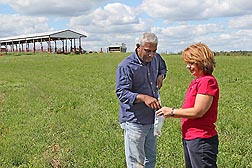Protecting Water Near Feedlots
Intensive management practices used on cattle feedlot sites can produce large concentrations of manure with excess nutrients, antibiotics, and microorganisms. The contaminants may end up in surface and ground waters, and minimizing such damage is important to feedlot operators.This is particularly challenging in Kentucky, where the limestone and “karst” terrain offers contaminants subterranean passage into underground caves, springs, and sinkholes. Cleaning up these sites is costly, and the big question is how to apply resources to the right areas.Spatial sampling and mapping is one of the best tools available to identify the most intensively contaminated areas, find out how contaminants have spread, and decide which areas need the most attention. The ultimate goal is to help producers develop management strategies that minimize contaminant loads.
Kim Cook and Karamat Sistani, at the Agricultural Research Service’s Animal Waste Management Research Unit, in Bowling Green, Kentucky, along with collaborators at Western Kentucky University in Bowling Green and at ARS in Beltsville, Maryland, are using GIS (geographic information system) technologies to map the distribution of contaminants across feedlot sites. Their approach is unique in its use of the technology to determine not just how nutrients flow through the soil, but also the fate of bacteria and pharmaceuticals given to cattle to protect their health.
The team measured the levels of contaminants in soil samples collected from a 5-acre feedlot used to grow out weaned calves for finishing. The site lies on a 4-degree slope with a feeding and watering area at the highest elevation, a grassy grazing area in the middle, and a shallow retention basin and sinkhole at the bottom. Most rainwater percolates into the soil, but heavy rain can cause flooding that fills the basin with water from the grazing area.
The researchers analyzed the soil for nutrients, including nitrogen and phosphorus; antibiotics used to treat diseases and enhance growth; and for microorganisms commonly used to indicate fecal contamination in waterways and soils—Escherichia coli, Bacteroides, and Enterococcus. The study was one of the first to simultaneously measure all three types of contaminants—nutrients, antibiotics, and indicator microorganisms—and to use GIS technology to map patterns of contaminant distribution.
The results, published in the Journal of Environmental Quality (2013), showed that nutrients, microorganisms, and antibiotics all largely stayed in the feeding area at the top of the slope.
“Analysis of contaminants, particularly antibiotics and microorganisms, on this scale is not very common. Incorporating the GIS mapping allowed us to visualize the distribution of all three contaminants in new ways. We were surprised to find that all were distributed in a similar manner and there was no distinct flow pattern downhill from the barn,” Cook says. The findings suggest that cleaning up the site may be more manageable than previously thought, with efforts focused on soil remediation in the feeding and nearby grazing areas where contaminants are concentrated.
To reduce nutrient loads, forage grasses that take up nutrients are now being raised on part of the site. The researchers are also evaluating soil treatments (alum, biochar, and gypsum) in the most contaminated areas to see if they will bind with the nutrients, antibiotics, and microorganisms and give them time to decompose in the soil.—By Dennis O'Brien, Agricultural Research Service Information Staff.
This research is part of Climate Change, Soils, and Emissions (#212) and Agricultural and Industrial Byproducts (#214), two ARS national programs described at www.nps.ars.usda.gov.
Kim Cook is in the USDA-ARS Animal Waste Management Research Unit, 230 Bennett Ln., Bowling Green, KY 42104; (270) 781-2579 ext. 232.
"Protecting Water Near Feedlots" was published in the November/December 2013 issue of Agricultural Research magazine.







